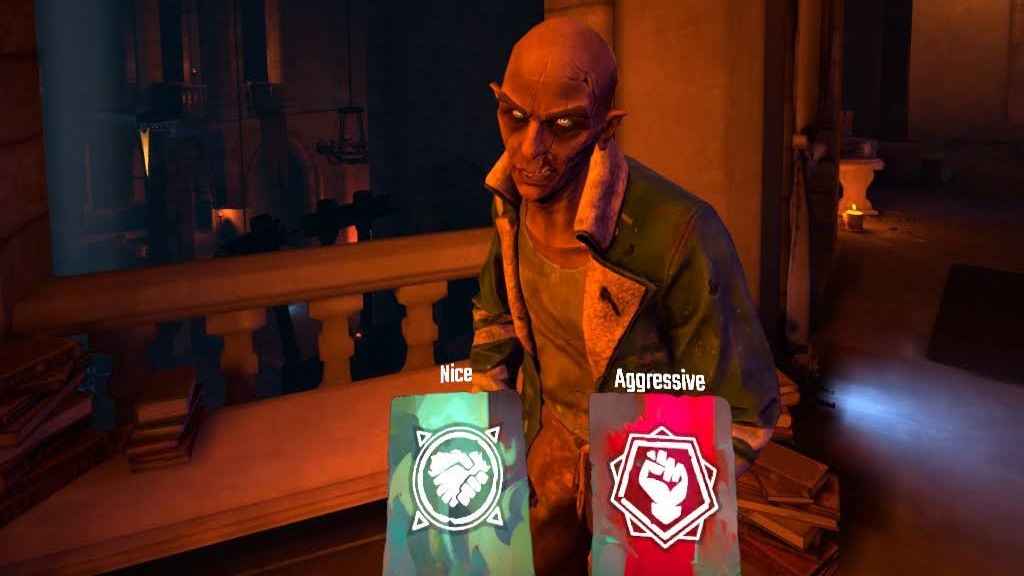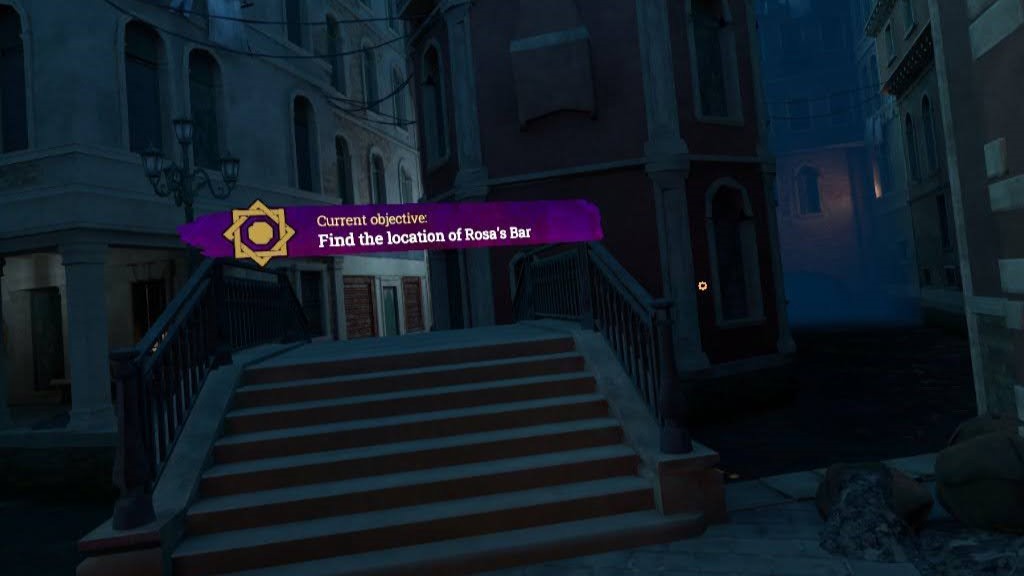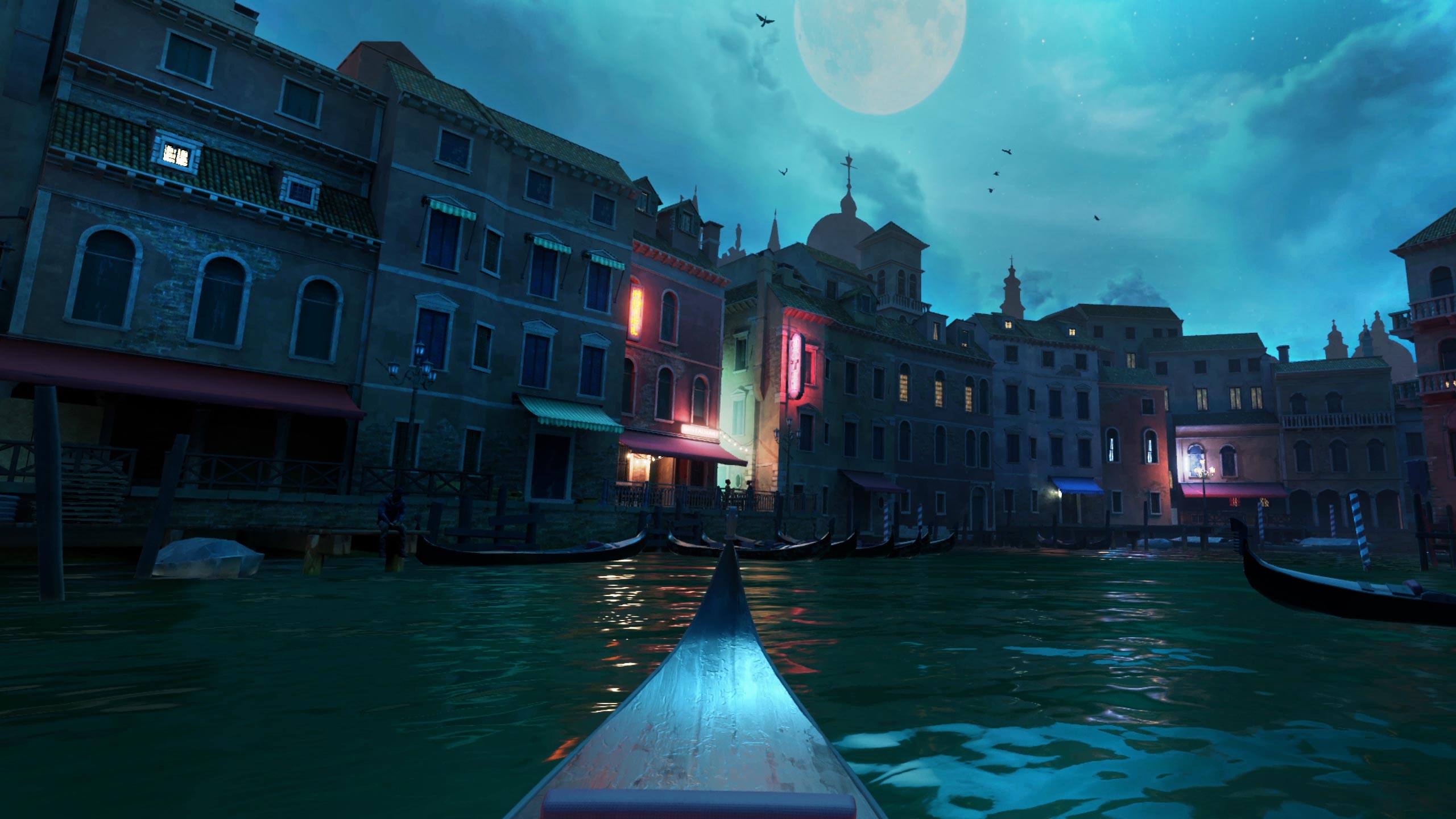The latest VR entry into to the World of Darkness universe lets you loose on the streets of Venice as a bloodsucking ghoul in search of you master’s killer and a stolen relic. Although it takes cues from stealth games like Hitman and Assassin’s Creed, Vampire: The Masquerade – Justice—let’s just call it Justice for short—takes a decidedly more linear approach to missions than I thought it might from our initial preview. This isn’t a terrible thing, although it manages to also feel pared down in a few other ways that’s just unfortunate. Read on to hear my full impressions.
Vampire: The Masquerade – Justice Details:
Available On: Quest, PSVR 2
Release Date: November 2nd, 2023
Price: $30
Developer: Fast Travel Games
Reviewed on: Quest 3
Gameplay
It’s your job to uncover the mystery behind your sire’s murder and reclaim a stolen relic, all of which is set in the claustrophobic alleys and sprawling sewers of Venice—yes, the world-famous sewer system of Venice. You know, the Italian island-city built on wooden stilts. With canals. And no basements. Because of the water. Ok, you’ll need to suspend disbelief only a tad more than you might normally for a fantasy world filled with vampiric factions, but not by much. After all, you can suck blood from people (and rats!), teleport around, and shoot mini-bolts formed from your own life force out of a Fisher-Price crossbow. What’s a sewer level or three? It’s all gravy.
Like pretty much all World of Darkness stuff, Justice is pretty pulpy when it comes to the narrative. If you’re not already an acolyte of the universe, the game does a pretty good job of introducing you to a few of the main vampire factions that come to a head. Still, you won’t need to absorb much of it, as it leads you by the hand through some pretty well-trodden territory which will probably feel like home for anyone who’s a fan of the gothic-punk vibe in general. That said, the suitably schlocky narrative spends a little too much time in the foreground for my tastes, especially considering it’s such a cookie-cutter tale with some pretty interchangeable villains and objectives.
For a game that mostly nails the ethereal feel of apparating onto the ledge of a building and blasting through an unsuspecting bad guy, I was really hoping it would provide me with a sort of Hitman-esque challenge of solving missions with my own creativity. Instead, it all feels a little hemmed in. Levels are typically large, although missions are entirely linear, meaning you’ll have to complete specific objectives that are force-fed to you by Pietro, your vampire pal and chief quest-giver. Don’t let that dialogue box fool you. You’re doing whatever Pietro says, even if you decide to be a little snotty about it. Anyway, that’s how it is with everyone you talk to in the game though, so it’s fine I guess?

The game is pretty intent on taking you by the hand to do most everything. By default, objectives are highlighted automatically, providing you with a far-off direction to point towards as you navigate through whoever and whatever is your way. You can see the little yellow geometric icon through the walls, which is more convenient than having to constantly refer to a map, but significantly less satisfying since it comes at the cost of exploration. I know that’s a thing in traditional gaming, but it feels just a little too abstracted in VR without giving me some sort of reason. Some cool AR glasses maybe? Nope. Vampires can just see objective markers.
Additionally, you can also activate a vampiric sense that gives you a whispy trail towards intermediary objectives, which most often times are keys to open doors. You can abuse it as much as you want, which is a clear temptation when you’re just looking to get to the ‘Mission Complete’ screen.

That said, the game’s combat is a high point, offering you several ways to dispatch baddies. Kills feel iconic and fun, although the skill difficulty is almost comically low since bad guys just never look up—not even if you call attention to yourself by dropping a brick or beer bottle. You can saunter around ledges and scurry up drainpipes to your heart’s content, never being in any danger, save the two or three times in the game when there’s a sniper.
And yes, the game’s singular way of getting from ledge to ledge is teleporting, which may disappoint anyone who was looking for a parkour experience. Still, it feels right here since it’s actually a vampire superpower, although I can see why some people may miss hitting ‘A’ for jump.

It’s not all rooftop-trawling at midnight though. When you need to move among them at street level, you really have one of two real options: go ham and kill before you catch two or three bullets, putting you back to your last automatic save point, or use some of your life force by turning invisible and walking right on by. Enemies seem to have radios, but it doesn’t appear they know how to use them very well, as you’ll kill a dude, his friend will come over and be like “oh no!” and then he’ll wander away eventually because you’re sitting on a ledge just above his head.
You can also always see where baddies are in level, since your vampire abilities not only provide a yellow highlighted heart icon, but also a cone that indicates which way they’re looking at any given time. Basically, the only way to be caught off guard is to close your eyes.
These aren’t the only ways to skin a cat, although you’ll probably land on your favorite method pretty quickly, as all enemies are basically the same, save three bosses you have to contend with. Different powers can be purchased in-game via XP, which includes things like that invisibility cloak ability, but also powerful and noisy attacks that boil the blood of victims until they explode. You can also set a something called a Shadow Trap that opens a pit to hell, but I found my own method pretty much the only real tactic for quick and easy kills. Using the crossbow, you can fire sleep-inducing bolts into everyone but bosses, and either knock them out to sneak by, or keep them still so you can suck their blood. It’s a pretty handy little device that feels well designed in terms of VR interactions, as it requires you to craft bolts, load individually, and cock back manually. You really don’t need anything else to beat the game, which took me about eight hours.
In the end, Justice has some really solid footing in terms of combat and level design, but it doesn’t really know how to leverage both of these things to make enemy encounters continuously feel fresh and engaging since baddies are fairly dumb and easy to kill. Besides some environmental puzzles, there aren’t a lot of objectives out there that I really used my brain to complete, as most of it’s a breadcrumb trail to the next thing and some dudes in the way.
Immersion
Justice feels like it wants to be an open-world game, but as we all know, that’s an order of magnitude more costly to build, which just isn’t in the cards for this decidedly more cheap and cheerful $30 adventure. While there is an ‘over world’ that you can freely prowl around, simply called ‘The Streets’, it really only serves as an intermediate area between you and the actual mission at hand. You can kill a dude to get some health before heading in, but there’s really not much going on.

That honestly doesn’t bother me, since the game never promised that. What does bother me though is unreliable object interaction. Like we noted in our preview earlier this year, object interaction feels flighty and not nearly as solid as it should be. Manipulating levers and other puzzle elements is a crapshoot, and picking up a rat-sized snack is basically like doing surgery with mittens. This does a great deal to hamper immersion, as it feels like the game really isn’t at home with up close interactions, preferring instead to relegate most of its interactions to superpower moves, crossbow shooting, and force-grabbing.
While a little rough around the edges, its set pieces and level design are both very good, providing a constantly changing environment that feels like it’s modeled after the real-world Venice (save the sewers). Justice is mostly awesome-looking, and I only wish there were more of it to explore and interact with, as it does an excellent job of creating a believable underworld in a fantasy version of Venice.
Comfort
You’ll be zipping around a lot in Justice, although since it entirely relies on teleportation to move from plane to plane, it does a lot to mitigate confort issues. Playing for hours on end wasn’t an issue for me, and that’s coming from someone who never uses smooth turning as an option for the fear of the dreaded flop sweats. Both lateral and forward motion can be mitigated by variable vignettes, which is a neat little extra that will make sure most anyone can play Justice from start to finish without issue.
‘Vampire: The Masquerade – Justice’ Comfort Settings – October 31st, 2023 |
|
Turning |
|
| Artificial turning | ✔ |
| Snap-turn | ✔ |
| Quick-turn | ✖ |
| Smooth-turn | ✔ |
Movement |
|
| Artificial movement | ✔ |
| Teleport-move | ✔ |
| Dash-move | ✖ |
| Smooth-move | ✔ |
| Blinders | ✔ |
| Head-based | ✔ |
| Controller-based | ✖ |
| Swappable movement hand | ✖ |
Posture |
|
| Standing mode | ✔ |
| Seated mode | ✔ |
| Artificial crouch | ✔ |
| Real crouch | ✔ |
Accessibility |
|
| Subtitles | ✔ |
| Languages | English, French, German, Spanish, Korean, Japanese |
| Dialogue audio | ✔ |
| Languages | English |
| Adjustable difficulty | ✖ |
| Two hands required | ✔ |
| Real crouch required | ✖ |
| Hearing required | ✖ |
| Adjustable player height | ✖ |
This post was originally published on this site be sure to check out more of their content.








